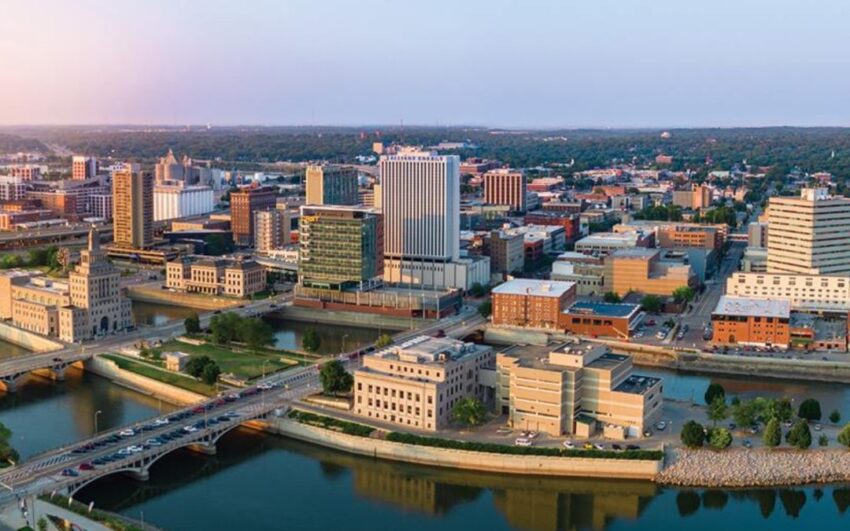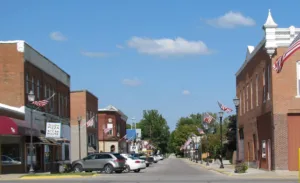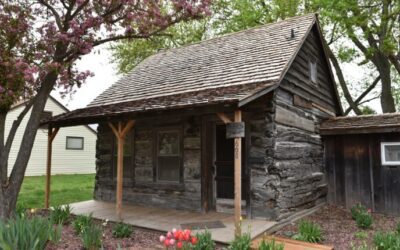
Iowa officially became the 29th state in the nation on Dec. 28, 1846. Interestingly enough, several cities had been up and running for years before official statehood.
While Native American tribes had for many generations called the land later known as Iowa home, white settlers started making their way to the land west of the Mississippi River in the late 1700s and early 1800s.
It’s not surprising to know that many of the cities located along the Mississippi River were among the first to be settled and then incorporated into the state, followed by a westward expansion across the state.
Today, there are 947 incorporated municipalities in Iowa. Check out our list of the 10 oldest Iowa cities, which we have based largely on the official incorporation date according to the Iowa Secretary of State’s office, though we made a few exceptions to that rule where noted.
Dubuque
1833

Photo courtesy of City of Dubuque Government via Facebook
Admittedly, we are cheating a bit by listing Dubuque first on the list. It was not actually officially incorporated as a city in the state until 1857, which is later than other cities on the list, but it deserves first mention as its namesake settler Julien Dubuque is widely known as the first white settler to the area in 1785.
Dubuque befriended members of the Meskwaki tribe, also known by some as Fox Indians, and learned of their lead mining operations in the area. He operated the Mines of Spain until his death in 1810. Years later, in 1833, the US government opened the land in Dubuque for settlement and the town grew from there, drawing many Irish and German immigrants.
Located at a unique junction on the Mississippi River—where Iowa, Illinois, and Wisconsin meet—Dubuque has long been a hub of educational, industrial, cultural, and commercial activity for that tri-state region. The city was officially incorporated in 1857 and it has been growing ever since. Today, nearly 60,000 people call this river city home.
Farmington
1841

Photo courtesy of Farmington, Iowa via Facebook
Farmington is the first official city incorporated into the state of Iowa. Located near the southeastern edge of the state, today there are less than 1,000 residents living there. It was first laid out in 1839 along the east bank of the Des Moines River and named after Farmington, Connecticut, where some of its first settlers came from. The town was incorporated in 1841. It is also the oldest of the 11 villages of Van Buren County, a popular tourist destination for its historic importance, beautiful natural scenery, and slower pace of life.
Burlington
1845

Photo courtesy of City of Burlington, Iowa Government via Facebook
Next up is Burlington. Also located on the banks of the Mighty Mississippi, it was incorporated in 1845. The Sac and Fox Indians called the area home before the Black Hawk Purchase in 1832, which brough white settlers who began exploring and building on the west bank of the river.
John Gray is credited with being the first landowner in Burlington, naming the town after his hometown in Vermont. It was deemed the first territorial capital of Iowa before statehood. One particularly unique feature in Burlington is Snake Alley. Built in 1894, Snake Alley is one of the most crooked streets in the country as it winds its way up the hillside from downtown. Today, some 24,000 residents call Burlington home.
Keokuk
1848
Keokuk is tucked right along the Mississippi River, at Lock and Dam No. 19, where it meets the Des Moines River. Named after the Sauk chief Keokuk, whose people first lived on the land and who is thought to be buried in a city park, Iowa’s southernmost city was incorporated in 1848.
The first white settler to the area, Dr. Samuel C. Muir is said to have made his home there so as to remain married to his wife, who was Native American. He resigned his position in the US Army when a retroactive order banned soldiers from marrying native women. The settlement was also part of the land designated in 1824 by the government as a place where mixed-race descendants of the Sauk and Fox tribes could live.
As river steamboat traffic increased in the early 1800s, the population of Keokuk grew and the American Fur Company was established. Today, about 9,000 residents call Keokuk home.
Cedar Rapids
1849
If you’re looking for rapids on the Cedar River, you might be surprised when you visit Cedar Rapids. While the river does flow right through the middle of downtown, there aren’t many rapids to be seen these days. Also originally part of the Sac and Fox tribes territory, white settlers who were reportedly of shady character—known horse and land thieves—came to what would later be named Cedar Rapids.
The city’s official founders are George Greene and Nicholas Brown, among a few others who came to the area in the 1840s to build a mill along the river (where there were actual rapids at the time). Soon after incorporation in 1849, the city started really growing in size, thanks in part to a large influx of Czech immigrants who settled there and created a lasting cultural impact.
The second biggest city in the state—currently home to about 138,000 people—today Cedar Rapids is an economic and cultural hub in eastern Iowa and the Interstate 380 corridor.
Muscatine
1851
Much like Dubuque, Bellevue, and Keokuk, Muscatine opened up for settlement by non-indigenous peoples after the Black Hawk Purchase in 1832. Thanks to its location on the Mississippi River—situated south of Dubuque and Bellevue, north of Burlington and Keokuk—it grew from its humble beginnings as a popular trading post for settlers passing through the area heading west.
An early settler created a steamboat landing called Casey’s Woodpile and the name stuck for several years before being officially named Muscatine and incorporated in 1851. In the early 1900s, Muscatine was known as the “pearl button capital of the world” thanks to mussel harvests that led to the production of 1.5 billion pearl buttons per year. While production ceased in the 1920s, today you can visit a museum that shares this unique history. Nearly 24,000 residents call Muscatine home today.
Bellevue
1851

Photo courtesy of City of Bellevue, Iowa / Bellevue Police Department via Facebook
Another Mississippi River town, Bellevue was also incorporated into Iowa in 1851. It sits at Lock and Dam No. 12 on the river, nestled between two large bluffs. When looking at the outline of the state, one could say it sits squarely on the bridge of the nose of Iowa.
The beautiful views account for part of the inspiration for the town’s name (with French influences), but credit must also be given to early settler John D. Bell, the town’s first postmaster. Bell laid out the city in the mid-1800s. About 2,300 residents call Bellevue home now and plenty of tourists continue to flock to enjoy the beautiful views of this notable river city.
Keosauqua
1851

Photo courtesy of Keosauqua Chamber via Facebook
This small town makes the list of oldest cities having also been incorporated in 1851, a big year for Iowa incorporations. Located on the distinctive big horseshoe bend in the Des Moines River, this small town gets its name from the Meskwaki and Sauk translations for…you guessed it…“bend in the river.”
A historic destination in southeastern Iowa, the town was first laid out in 1839, has long been the county seat of Van Buren County, and is home to the state’s oldest county courthouse. The Hotel Manning, a three-story structure built in the height of the steamboat era in the mid-1800s, still stands today. While less than 1,000 people now call Keosauqua home, the long list of registered historic sites makes the town a tourism draw.
Des Moines
1851

Photo courtesy of Catch Des Moines via Facebook
First incorporated as Fort Des Moines, named for a fort built in 1843 to protect the Sauk and Meskwaki tribes, the name of this popular city was shortened to just Des Moines in 1857 when it became the state’s official capital city. While the city was renamed beforehand, the fort became a major military base for the Union Army during the Civil War.
The city is located on and named after the Des Moines River, believed to be inspired by French settlers mishearing Native Americans pronounce the word “Moingona,” which referred to a path between two waterways. Located at the heart of the state, Des Moines features a stately capital building with five golden domes that rise distinctly from the surrounding corn and soybean fields that dominate central Iowa.
Archeological research has found that prehistoric inhabitants lived in the area at the intersection of the Des Moines and Raccoon River more than 7,000 years ago. At least three prehistoric villages have been excavated, dating from 1300-1700. Des Moines’ latest official census records boast more than 214,000 people, but the ever-growing greater Des Moines area—the most densely populated part of the state—includes nearly 700,000 residents.
Council Bluffs
1853
The list finally takes us to the farthest westward reaches of the state with Council Bluffs, which also happens to sit along the banks of another of the country’s navigable rivers: the Missouri (who said Iowa is land-locked?). It was first established as a trading post in 1824 by a St. Louis businessman and fur trader named Francois Guittar, who created the first white settlement on the western boundary of the Iowa territory and named it Traders Point.
As it grew to be an active trading outpost, known to be a relatively safe area with friendly relationships between settlers and local Indian tribes, it became a crossing point on the Missouri River for many pioneers heading west on the Oregon, California, Mormon, and Lewis and Clark trails. In fact, the town also went by the name Kanesville for a time, named such by Mormon settlers passing through the area, before it was officially incorporated in 1853 as Council Bluffs. It then grew quickly when the railroad came to town, connecting Council Bluffs to the farther reaches of the country. Today considered an extension of the Omaha metropolitan area, it is home to more than 62,000 residents.
Iowa City
1853

Photo courtesy of The City of Iowa City Government via Facebook
Again, we may be breaking our own rules by adding an 11th city to the list, but Iowa City was officially incorporated as a city in Iowa just days after Council Bluffs, in the cold winter of January 1853. The city played an important role in state history. Perhaps you could have guessed from the distinctive Old Capitol building at the heart of the University of Iowa’s campus, but Iowa City was actually the state’s first capital city until it moved to Des Moines in 1857.
People were living in Iowa City long before its official incorporation, however, as it was deemed a capital of the Iowa territory in 1839. The city grew up around the bluffs of the Iowa River and today its downtown core remains in much the same footprint as where it was located in the mid-1800s. Named a UNESCO City of Literature—one of only two in the United States—in 2008, today Iowa City is home to some 75,000 residents, plus students attending the University of Iowa.

10 best books set in Iowa
Discover the 10 best books set in Iowa, capturing the essence of its heartland charm, rural landscapes, and unforgettable stories. Author Jhumpa...

The deadliest natural disasters in Iowa history
Iowans are no stranger to severe weather. Learn more about some of Iowa’s deadliest natural disasters, from floods and tornadoes to droughts and...

Iowa towns named after famous places
Hit the road and check out these Iowa towns that may or may not be mistaken for popular cities around the world. Iowa may be smack dab in the middle...

What to know about Labor Day and its history
By JAMIE STENGLE Associated Press DALLAS (AP) — From barbecues to getaways to shopping the sales, many people across the U.S. mark Labor Day — the...

The fascinating story behind Lake Sugema’s name
Learn about Lake Sugema, from its history and how it was named to the wildlife that calls it home. What began as a project to prevent soil loss,...

7 of the most infamous Iowa criminals
Learn more about seven of the most infamous Iowa criminals to serve time behind bars. Something about criminals and the crimes they committed is so...





